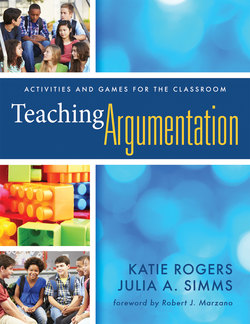Читать книгу Teaching Argumentation - Julia A. Simms - Страница 9
На сайте Литреса книга снята с продажи.
ОглавлениеForeword
In 1984, I attended an invitational conference at the Wingspread Conference Center in Racine, Wisconsin. The purpose of the gathering was to ask interested educators how to best contribute to the burgeoning interest in teaching thinking skills. Although many possibilities were suggested (and many came to fruition), six other educators and I were particularly involved in the development of a framework and curriculum designed to enhance students’ thinking and reasoning skills.
The centerpiece of both our framework and the curriculum materials was argumentation. Skills such as observing, formulating questions, comparing, classifying, analyzing, identifying errors, inferring, and drawing conclusions formed the backbone of our work. Throughout the 1980s and 1990s we interacted with thousands of teachers and students in hundreds of schools, helping them to better understand the complex processes associated with argumentation and other thinking processes and skills.
One memory from this time is particularly powerful for me. While studying World War II, a teacher asked his students to make inferences regarding how the Nazis could have justified the killing of millions of Jewish people simply because of their race and ancestry. Students compiled a vast amount of information and observations: quotes from Mein Kampf, excerpts from letters, examples of Nazi propaganda, and so on. Observations and information covered the walls of the classroom. As the teacher guided his students through the process of classifying, comparing, analyzing, and examining their collected information, students generated a particularly powerful conclusion: the heart of prejudicial thinking is sound reasoning from untrue premises. This conclusion expressed what had happened in Nazi Germany during World War II so eloquently and so clearly that I have remembered it ever since.
This story was not an isolated incident. During the two decades I spent training teachers and leaders to implement direct instruction in thinking, reasoning, and argumentation skills, I was consistently astounded by the effects of this type of instruction on students. Free, critical, and creative thought is a bedrock of our society, and it made perfect sense to provide direct instruction in this kind of thinking in our schools. Unfortunately, as often happens in education, the thinking skills movement eventually waned as other topics and issues came to the forefront of research and policy. Such a powerful movement seemed to have been cut short before its time.
Not surprisingly, then, I was delighted to see the renewed emphasis on argumentation and thinking skills in the Common Core State Standards (CCSS). Throughout the college and career readiness, mathematical practice, and English language arts and mathematics content standards, students are asked to analyze arguments, present claims, construct support, explain relationships between argument elements, identify errors in reasoning, evaluate rhetoric, and so on. These foundational skills were powerful twenty years ago and are still powerful today.
With this renewed awareness of the importance of argumentation comes a need for teachers to seriously consider how best to teach and support argumentation in the classroom. Although various programs are rapidly becoming available, teachers who are already pressed for time may not be able to carve out the additional hours these types of curricula require. For this reason, I strongly support the authors’ efforts in this book to provide clear, concise, concrete guidance to teachers about specific argumentation skills from the CCSS, how to teach them in concert with the content students are already required to learn, and how to reinforce them through fun, engaging activities and games.
Rogers and Simms have created an accessible, research-based resource that teachers can use on a daily basis in their classrooms. They’ve prepared everything teachers will need: a wealth of examples, items, templates, and other resources so that each skill is ready to teach and every game is ready to play. Busy teachers will appreciate the authors’ attention to detail and their awareness of the bigger context of the classroom, the CCSS, and the unique needs and situations of teachers, students, and schools. I highly recommend this book to all K–12 educators and look forward to seeing educators take direct instruction in argumentation to new levels of implementation.
—Robert J. Marzano
